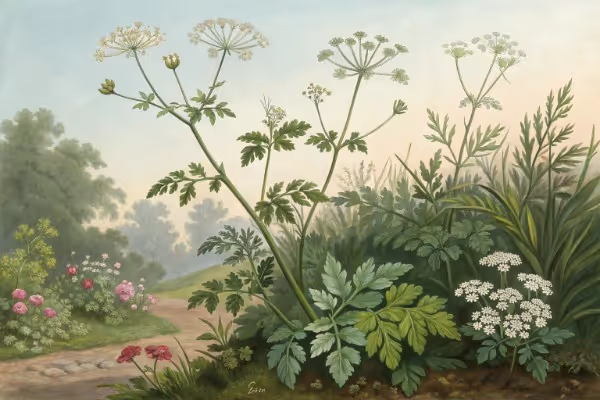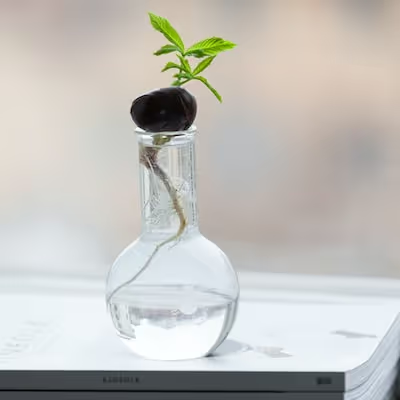Growing Cumin: A Practical Guide for Fragrant Harvests

Growing Cumin
Growing cumin rewards patient gardeners with aromatic seeds and flavorful foliage suited to warm, sunny climates. Sow cumin seeds directly outdoors once spring temperatures reach above 60°F, ensuring loose, well-drained soil. Keep plants comfortably spaced—around 6 inches apart—to promote healthy airflow and vigorous growth. While cumin can test your patience, its rich culinary and medicinal benefits make this aromatic herb worth your time. Here's how to master growing cumin from planting to harvest.
Cheatsheet: Cumin Cultivation for Aromatic Seeds
🌱 Site & Soil
Full sun, well-drained sandy loam. pH 6.8–8.3. Avoid clay.
🕰️ Sowing & Timing
- Start seeds indoors 4 weeks before last frost (spring): 70°F/21°C soil.
- Direct sow only where summers exceed 120 frost-free days.
- Plant ¼ in/6 mm deep. Space 4 in/10 cm apart.
💧 Watering & Care
- Keep soil moist, never soggy.
- Thin to 8 in/20 cm when true leaves show.
- Avoid over-fertilizing. Too much nitrogen = lush leaves, fewer seeds.
🌼 Flowering & Pollination
- Umbels appear in 60–70 days. Attracts pollinators.
- 80–120 days to seed harvest.
✂️ Harvest & Processing
- Snip stems when seed heads turn brown, before seeds drop.
- Hang upside down in paper bags to dry 1–2 weeks.
- Rub umbels to release seeds. Store airtight, cool, dark.
🧰 Tools and Products You’ll Need
- Seed trays or pots
- Fine seed starting mix
- Cumin seeds
- Watering can
- Pruners or scissors
- Paper bags for drying
- Airtight glass jars
🍽️ Benefits & Uses
- Rich in iron, antioxidants, and aids digestion.
- Boosts self-sufficiency: one plant may yield 8–10g seed.
- Fresh-ground cumin magnifies flavor in global cuisines.
⚡ Fast Facts
- 70% of cumin worldwide is grown in India.
- One tablespoon = 22 calories, 1.4g iron.
- Stores up to 1 year whole, 6 months ground.
-
Growing Cumin: a practical guide for fragrant harvests
Growing Cumin rewards patience with an aroma that dwarfs anything in a jar. Cuminum cyminum is an annual in the carrot family that loves heat, hates wet feet, and finishes in roughly 100 to 120 frost-free days.
I grow it for one reason. Freshly cracked seeds make a skillet smell like a spice bazaar and a desert breeze at the same time.
Climate, timing, and germination
Sow after the last frost once soil holds steady at 68 to 77 F, which is 20 to 25 C. I seed in place, because the plant builds a deep taproot that sulks if disturbed.
Give it a long warm run. Cool nights slow growth and invite mildew.
ICAR-NRCSS, Ajmer: “Optimal soil temperature for cumin germination is 20 to 25 C, and the crop thrives in dry, warm conditions.”
Sun, soil, and bed prep
Full sun is non-negotiable for Growing Cumin. Aim for 6 to 8 hours of direct light and low humidity if you can swing it.
Loose, fast-draining loam with pH 6.8 to 7.5 keeps roots happy. I fork in fine compost and a light sprinkle of balanced organic fertilizer at planting, then stop.
Seeding, spacing, and thinning
Plant seeds 0.25 inch deep, about 6 mm. Space 2 inches apart in rows 12 to 18 inches apart, which is 30 to 45 cm, then thin to 4 to 6 inches, or 10 to 15 cm.
Seedlings look like wispy dill cousins, so mark the row. I mix in a few radish seeds as a quick row marker and to break crust.
Water and feeding
Keep soil lightly moist for germination, then water deeply but infrequently. I target 0.5 inch per week, 13 mm, during dry spells and skip if humidity spikes.
Overfeeding pushes lush foliage and invites disease. A modest top-dress of compost at 30 days works better than nitrogen-heavy feeds.
Mulch and airflow
A thin mulch of shredded leaves or straw holds moisture without smothering stems. Good airflow is your powdery mildew insurance policy.
I space wider if my summer turns muggy. Dry air grows better cumin than crowded beds.
Pests and disease control
Aphids and spider mites wander in during hot spells. I release lacewings and spray with a mild soap solution at dusk.
Powdery mildew shows up in humid pockets. I prune a few inner stems for airflow and switch to morning watering.
Damping-off can clip seedlings in cool, wet soil. Pre-warm beds with a low tunnel if your spring starts chilly.
Companions and rotations
Umbels attract hoverflies and parasitoid wasps, so I interplant with cilantro, calendula, and alyssum. Fennel nearby tends to hoard insects, so I give it a separate corner.
Rotate out of Apiaceae beds for 2 to 3 years to dodge soilborne trouble. Carrots, dill, and parsley count in that rotation math.
Containers and small spaces
Cumin tolerates pots if they are at least 10 inches deep, or 25 cm, with gritty mix. I blend 50 percent high-quality potting mix with 30 percent compost and 20 percent coarse sand.
Keep containers on the dry side and in full sun. A clay pot helps by breathing off excess moisture.
Indoors and short seasons
If your frost-free window is under 100 days, start seeds in biodegradable cells 3 to 4 weeks before last frost on a heat mat set to 70 F, or 21 C. Transplant gently once nights stay above 55 F, which is 13 C.
I harden off slowly for a week, then set a clear tunnel over the row to hold heat during spring swings.
Harvest, curing, and storage
Heads turn tan and seeds harden at 90 to 120 days. Harvest before they shatter on a hot, dry afternoon.
I cut whole umbels, bag them upside down in paper, and finish-dry in a shaded, airy room at 95 to 105 F, or 35 to 40 C. Then I thresh by hand and winnow with a cheap box fan.
Store whole seeds in airtight glass away from light. Flavor holds for a year, sometimes longer, but the top notes sing in the first 6 months.
Green cumin and flavor notes
For a bright, resinous hit, pick a few sprigs when seeds are green and soft. I toss them into lentils like you would fresh dill heads in pickles.
Dry the rest for pantry spice. Toast lightly in a dry pan before grinding to unlock the citrus and smoke.
Grocery store seed vs. seed packets
Whole cumin from a spice aisle sometimes sprouts if it hasn’t been heat treated or irradiated. Organic, unprocessed seed gives the best odds, though germination runs patchy.
I use packets from reputable seed houses for reliable stands. Grocery seed is my backup experiment, not my plan.
Look-alikes and name mix-ups
- Cumin, Cuminum cyminum: warm-season annual, tan seeds, classic taco-and-tadka aroma.
- Caraway, Carum carvi: cooler-season biennial, crescent seeds with anise bite, better in rye bread than chili.
- “Black cumin”: often Nigella sativa with oniony spice; true black cumin is Bunium persicum and prefers high, dry mountains.
- Coriander, Coriandrum sativum: coriander seed is round and citrusy, while cilantro is the leaf from the same plant.
Yield expectations
In my beds, 10 square feet, roughly 0.9 square meters, produces 3 to 6 ounces of clean seed, which is 85 to 170 grams. Dry weather boosts yield and flavor purity.
Heavy rain during flowering washes nectar and stalls pollinators. I hedge with a low tunnel if storms line up.
Seed saving at home
Cumin is insect-pollinated and can cross with other cumin types. For pure seed, cage a few plants with fine mesh and shake flowers daily to move pollen.
Dry seed to 8 to 9 percent moisture for storage. A simple test is a snapped seed that breaks cleanly, not bends.
Top cultivars I trust
- ‘Kamini’: early, compact plants that finish in about 100 days in my zone 6 garden.
- ‘RZ-19’ type lines: uniform umbels, steady in variable springs.
- Heirloom landrace mixes from dry climates: complex flavor, modest yields, worth a row for cooks.
Tools and supplies that make Growing Cumin easier
- Heat mat with thermostat for steady 70 F, 21 C starts.
- Biodegradable plug trays to spare the taproot.
- Lightweight row cover or insect net for early warmth and aphid pressure.
- Drip line with 0.5 gph emitters for precise, infrequent watering.
- Fine mesh produce bags for drying umbels upside down.
- Hand mill or burr grinder set coarse, then finish in a mortar for fresh spice.
- Glass spice jars with one-way valve lids or tight bail-top jars for long storage.
Commercial context and a global snapshot
FAO and Spices Board of India report that India dominates both production and exports of cumin, supplying a large share of the world market each year.
Seed quality varies by origin and post-harvest handling. I buy from vendors that publish germination tests and harvest year.
Troubleshooting fast
- Patchy germination: warm the soil, 68 to 77 F or 20 to 25 C, scarify lightly, and keep evenly moist with a fine rose.
- Leggy seedlings: increase light to 14 hours and reduce heat after sprout to 65 F, 18 C.
- Yellowing leaves midseason: back off water and check drainage before feeding.
- Powdery mildew: thin for airflow, switch to morning irrigation, and spray sulfur only if humidity lingers.
- Seeds shattering: harvest earlier in the day and bag umbels before field-drying.
Soil science in plain terms
Sandy loam with high porosity lets that taproot chase depth. If your soil holds water, amend with coarse sand or expanded shale to keep oxygen around the root hairs.
Electrical conductivity above 3 dS m−1 can tip plants into stress. I keep salts low by flushing pots monthly and spacing fertigation.
From bed to kitchen
I toast a small batch, grind only what I need, and keep the rest whole. Freshly milled cumin can carry a stew, spark a roasted carrot, or fix a flat-tasting rub.
A good rule is one level teaspoon whole seed per pound of beans, then adjust. Your nose will tell you when you hit the mark.
Anecdotes from hot, dry summers
My best cumin came in a summer that would make a lizard squint. Low dew points, regular deep irrigation, and ruthless thinning gave tall, clean umbels.
The only time I lost a crop, I babied it with overhead sprinklers in humid weather. I learned and switched to drip, and the mildew ghosts left.
Data-backed notes and references I trust
- ICAR-NRCSS, Ajmer, India: agronomy of cumin under arid and semi-arid conditions.
- FAOSTAT and Spices Board of India: production and trade snapshots for cumin.
- USDA-ARS GRIN and Kew Science: taxonomy, origin, and botany for Cuminum cyminum.
- University and extension bulletins on powdery mildew and drip irrigation scheduling for herbs in hot climates.
Quick FAQ for Growing Cumin
Can I succession plant cumin for extended harvests? I run two sowings spaced 3 weeks apart so shattering risk doesn’t land all at once.
Does pruning help? Light tip pinches at 4 to 5 inches tall, 10 to 13 cm, can branch umbels and bump yield in rich soil.
Will cumin grow under lights? Yes, use full-spectrum LEDs at 250 to 350 µmol m−2 s−1 and keep canopy temps at 75 F, 24 C, then finish outdoors for seed set.
Answers to Common Questions About Growing Cumin
What soil conditions best support cumin cultivation?
Cumin thrives in sandy, well-drained soils with a neutral to slightly alkaline pH level between 6.8 and 8.3. Amend heavier soils with compost or sand to improve drainage and prevent waterlogging.
How much sunlight does cumin require to grow successfully?
To produce a healthy crop, cumin plants require full sun exposure, ideally 6 to 8 hours daily. Plenty of sunlight ensures vigorous growth and increases essential oil production in the seeds.
What is the ideal spacing between cumin plants?
Space cumin seeds approximately 4 to 6 inches (10 to 15 cm) apart, with row spacing maintaining 12 to 24 inches (30 to 60 cm). Proper spacing encourages healthy airflow and reduces risks of disease.
How frequently should cumin be watered throughout the growing season?
Cumin prefers moderate watering; provide water when the top half-inch (1-2 cm) of soil feels dry. Avoid overwatering—consistency matters, so maintain even moisture without saturating the roots.
When and how should cumin be harvested?
Harvest cumin approximately 120 days after planting, when the seed heads turn brown and dry and seeds begin detaching easily. Clip the seed heads carefully, then thresh and air-dry seeds thoroughly before storing.
What temperature ranges suit cumin growth best?
Cumin performs optimally in temperatures ranging from 68°F to 86°F (20°C to 30°C). Avoid exposure to frost or prolonged cool temperatures, which stunt growth and reduce seed yields significantly.
Are there common pests or diseases to watch for during cumin growth?
Watch for pests such as aphids and spider mites, and fungal diseases like blight and powdery mildew. Promote good air circulation and proper watering techniques to prevent these problems—address infestations promptly with suitable organic solutions.
Can cumin be grown successfully in containers?
Yes, cumin grows effectively in containers. Select pots with adequate drainage holes and at least 10 inches (25 cm) depth. Ensure placement in a location receiving plentiful daily sunlight and monitor watering consistently to keep the soil moist but not saturated.
Growing cumin rewards patience and curiosity. Start with well-drained soil, plant after frost, and make sure your patch gets a full day’s sun. Water lightly—cumin hates wet feet. Thin seedlings for airflow and watch for pests that love that feathery foliage. When seed heads turn brown, snag them before the birds do. Dry thoroughly, crush gently, and stash your harvest in an airtight jar. That’s it—fragrant cumin from your own plot, ready for any dish that needs a punch of warmth. If you enjoyed this, you might also like the thrill of growing anise or the satisfaction of growing lentils at home. Here’s to bold flavors from a little effort and a lot of patience.
The Prepper’s Guide to Reliable Cumin Harvests
Long-Term Seed Storage
- Store cumin seeds airtight in dark glass or mylar bags with oxygen absorbers.
- Maintain storage temperatures consistently below 60°F (15°C) to sustain seed viability up to 4 years.
- Label clearly with harvest date to manage seed rotation systematically.
Water-Efficient Cultivation Methods
- Use drip irrigation at 1–2 gallons (4–8 liters) per week per square yard (0.8 m²).
- Employ deep mulching (straw or shredded leaves, 2 inches/5 cm thick) to conserve soil moisture effectively.
Nutritional Benefits for Self-Reliance
- Cumin seeds deliver notable iron content (4 mg per tablespoon/6 grams), aiding blood health without external supplements.
- Contain antioxidants beneficial for immunity and general wellness.
Seed Saving & Continuous Supply
- Allow cumin plants to flower fully; harvest seeds when dried, brittle, and brown.
- Separate seeds by gently threshing dried seed heads, winnowing chaff using breeze or gentle fan.
- Designate isolated garden patch (minimum 500 feet/150 meters) from wild cumin relatives to maintain seed purity annually.
Pest & Disease Resistance Strategies
- Interplant cumin with aromatic herbs (oregano, thyme) to deter aphids and mites naturally.
- Rotate cumin annually with legumes or brassicas to reduce pathogen buildup in soil.
Find out which plants will thrive in your garden!
Answer a few fun questions and get custom plant recommendations perfect for your space. Let’s grow something amazing together!

start your season





